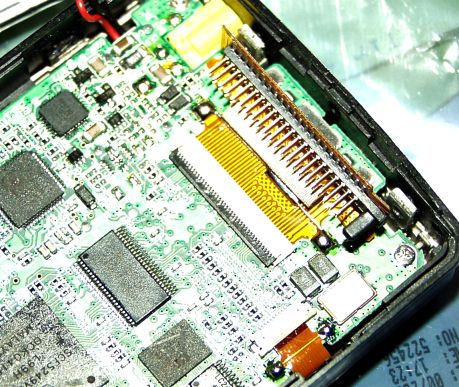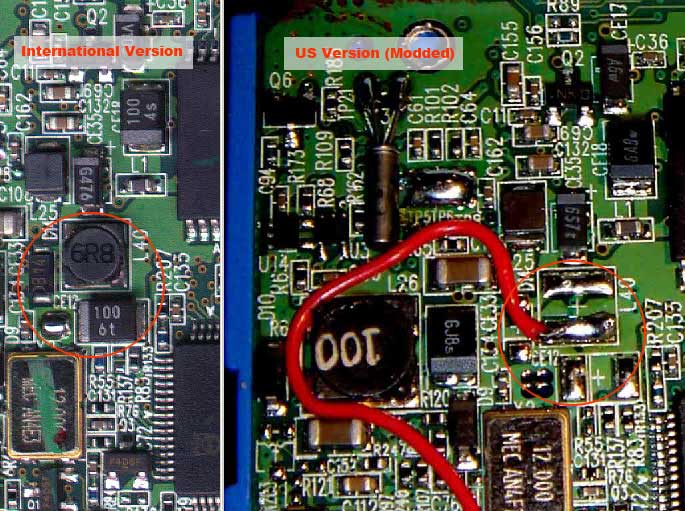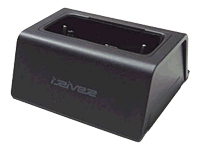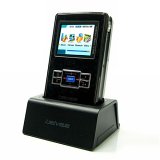
When I decided I wanted to get a DAP (Digital Audio Player), I had several criteria and preferences which led me to the iRiver H320 and the Cowon iAudio X5. The H320 is out of production now, but I was able to find a good used one on eBay for about $60, so I got that instead of the $230 X5.
The features I like about the H320 are these:
The preeminent DAP, the iPod, doesn't have most of these features, though many can be added with expensive add-ons (which means you have to carry a bunch of separate devices around with you all the time). The H320's newer rival, the Cowon X5, has most of them, but it has the annoying feature that you need to use a special "dongle" to plug in the AC adapter to recharge the battery, or to use the USB port. The iRiver has everything built-in, so while it might be slightly larger, there's nothing extra to get lost or fumble with.
My H320 was already a couple years old when I got it, so the battery wasn't working well at all. It probably ran for about 15 minutes before running out of power. In order to fix this, and also to improve the battery capacity beyond the original specs, I got a 2200mAh lithium battery from Sonnet Technologies for about $20. I haven't had a chance to run it down completely yet, but others who have done this have reported run times of over 20 hours! The H320 only had a 1300mAh battery in it originally, so this is surely much better performance than the player could manage when new.
In order to do this mod, you'll need to order a battery from Sonnet or Newertech which is intended for the 1st and 2nd generation iPods. The H320 has the same battery size as these early iPods, so any such battery should fit. However, because these larger batteries are slightly larger than the original, some modifications to the H320 are necessary.
To get started, you'll need to take apart your H320. There's some instructions on misticriver.net.
The first alteration necessary will be to the new battery itself. The H320 and iPod use the same physical connector, but the wires are reversed. This is easily changed. Using a jeweler's screwdriver, just lift up the small tabs holding the pins in the connector, and pull them out. Put them back in reversed.
The second alteration is to the inside of the case. Because the battery is slightly larger in all dimensions than the original, there's not quite enough room inside the case to fit it. To fix this, attach a cutting wheel to your Dremel and grind out the protruding tabs on the inside of the case back.
Follow the rest of the instructions about taking apart the H320 and replacing the battery, and you should have a player that works better than new.
Update: Don't buy that overpriced battery from Sonnet or Newertech! My Sonnet battery died after a month or two, exhibiting the infamous "ballooning" failure mode where the battery literally inflates because of gas build-up within the cell. This is usually noticed by the case coming apart because of the pressure, and if you're lucky, the hard drive won't be destroyed by this, but this also frequently happens.
Instead, go to Ebay and look for seller "eforcity". He sells a 1st-generation iPod replacement battery with the same 2200mAh capacity for only $6, including shipping. I've installed one of these and so far it's working just fine.
My H320, bought used on eBay, seemed to work fine at first, but when I tried to fill it up with music, I ran into a lot of data errors after about 12.5 GB. I tried reformatting, but the problem was still there, and at the same place, so it was apparent the hard drive was defective. I got around this problem temporarily by repartitioning the hard drive to have a single 12.5 GB partition, leaving the rest of the space unused, but this was obviously annoying since I had far less space for music.
Luckily, I managed to find a used 20 GB iPod hard drive on eBay for $15. This hard drive has the Apple logo on it, showing that it was specifically meant for iPods. Some people have expressed concern about using Apple-branded Toshiba drives in their iRivers, but personally I had no problems at all. I simply reformatted the drive using the H320's built-in format function, and it worked just fine.
Update: My 20 GB drive was damaged by the SonnetTech inflating battery and wouldn't work any more, so I returned to Ebay and got an even larger 30 GB iPod drive, the Toshiba MK3006GAL. It's the same physical size as the original 20 GB drive, and is recognized by the H320's firmware with no issues. This drive was also an iPod drive, and for some reason the H320 failed in its attempt to format it, so I just plugged it into my Linux machine's USB port, and used "fdisk" to wipe the partitions and create a single partition, and then "mkfs.vfat" to format it.
 |
| Hard Drive comparison |
Some H300 enthusiasts have expressed concern that all the newer 1.8" hard drives now use the so-called "ZIF" (zero insertion force) connector instead of the 40-pin connector used by the H320, and because of this our players won't be able to use any newer drives.
I believe this may be incorrect. When I took apart my player in order to change the battery and replace the hard drive, I noticed that the 40-pin connector was actually part of a FFC (flat flexible cable) that connected to the main circuit board with a ZIF connector. From data sheets I've read about both types of Toshiba hard drives, both types of drives have standard ATA (IDE) interfaces, just different connectors.
 |
| Hard Drive Connector |
So if my theory is correct, installing a ZIF-connector drive would be a simple matter of removing the 40-pin connector and cable, installing a 3-inch 40-pin 0.5-mm pitch FFC from Mouser or Digi-Key, and connecting this to the new drive. The only big challenge would be making sure to get the correct cable type, as there's two types, one with the pins exposed on the same side, and one with the pins exposed on opposite sides. The correct choice depends on the respective orientations of the two connectors, and also the positions of pin 1 on each connector (the cable can be folded if they're not aligned).
I probably won't have an opportunity to test this theory any time soon since my current 20 GB drive seems to be sufficient for my current needs, but when I outgrow it, I expect the ZIF drives to be more commonplace and the 40-pin drives to be older and more rare.
Update: Don't try this one unless you don't plan on using your H320 in a portable fashion, or have some way of creating a microminiature interface circuit board. This modification has been discussed on misticriver.net in some detail, and it turns out that while it is possible, the problem is that the 40 pins on the ZIF connector aren't in exactly the same order as on the H320's internal FFC and connector. At least one adventurous person has successfully interfaced a ZIF-connector drive to the H320, but this was done by soldering 40 individual wires between the two cables. Obviously, while this may work fine on a workbench, the player can't be reassembled properly like this, so for now, make sure to get drives which have the older 40-pin connector.
You may remember from the top of this page that I listed USB Host as a feature of the H320 that I wanted. Unfortunately, I didn't find out until after I got my H320 that this is not a normal feature of the US-market H320. There's two versions of the H320: the US version, and the "International" version that everyone else gets. The latter version has a fully-enabled USB Host port for connecting to cameras, flash card readers, USB thumb drives, etc. so you can copy files to and from these devices. However, those of us in the US were cheated of this, and instead that port is used for transferring DRMed WMA files downloaded from "PlaysForSure" online music stores like Napster. What a crock!
 |
| Comparison of US and international versions |
For one thing, buying DRMed music is stupid; why should I pay for music that limits where and when I can play it, and doesn't come in whatever format and bitrate I desire? It's simpler, more flexible, and more economical to simply buy CDs (many times used from places like SecondSpin) and then rip them. Also, I don't listen to bands where I only like one song on a CD, so that argument is moot for me.
I also find it interesting that only Americans get this "feature". I guess Americans are the only ones dumb enough to buy DRMed music, since they didn't bother making this feature available to those in other countries.
Since I have no intentions of ever buying any DRMed music, I feel rather cheated that I don't get to use the USB Host port and functionality that everyone else gets. However, there's hope: owners of US players can flash their H320s with the international firmware, which (permanently) removes the DRM ability and adds USB Host support. But there's a slight problem: iRiver left a few parts off the H320 circuit board on the US-market players. The data lines in the USB Host port work fine, but the port doesn't provide 5V power like a normal USB Host port does. Because of this, many devices don't work.
Most portable USB devices can't supply their own power, so they rely on power from the USB port they're plugged into. Examples of this include flash card readers and thumb drives. Also, some devices which do supply their own power still must detect 5V on the USB bus before activating it. That's the case with my Olympus E-10 camera.
Some people on Misticriver have come up with work-arounds, such as getting a battery-powered USB hub or hacking a USB Host cable to draw power from a battery pack, but I'd prefer not to lug any extra items around. Some people have added a wire inside their H320 to connect 5V from another part of the circuit board to the USB Host port. I plan to do this.
I found this cradle on Ebay for about $12, and it's somewhat useful for plugging in the H320 on my desk. It has both power and USB connectors on the back.

 |
I found this remote for about $20 on Ebay, and I find it extremely useful, especially when carrying the H320 in my pocket. This remote clips on my jacket and shows all the relevant information on the LCD display, and lets me adjust volume, track, etc. without having to take the main unit out of my pocket.
 |
| iRiver Remote |